QuestionI have a 55 gallon fresh water aquarium and I have had it for 2 months now. It has been constantly cloudy. So cloudy you can see the particles floating in the water. Even heavy things like fish waste stay floating. I have tried everything I can find on the internet (procedures, not chemicals) and nothing makes a difference. The tank has cycled a few weeks back
Fish
3 Guarami
3 Albino Tiger Barb
5 Prestilla Tetra
3 Serpea Tetra
5 Coryadora Catfish
3 Angel Fish
2 Sword Tail
4 Green Barb
4 Tiger Barb
2 Lier Tail Mollies
4 Clown Loach
2 Red Tail Shark
2 Rainbow Shark
I have a Marineland Penguin 330 Bio Wheel Power Filter System
I keep the temp between 76 and 82
The lights are on 8 to 10 hours a day
I have no signs of algea
I have about one inch to an inch and a half of small gravel ( sand blasting gravel? )
No live plants.
Only rocks and plants are from Pet store
I use TetraColor Tropical Fish Flakes
I feed them the flakes around 6am and I feed them a frozen shrimp brine cube in the afternoon around 4-6
I do 25% water changes weekly
I vacuum the gravel with a siphon kit at water change intervals
I put one cap of Prime in the water at each water change
After the tank Cycled, I changed one fiter, then 2 weeks later, I changed the other filter.
There are about 3 or 4 fish that can't seem to resist bouncing off of a rock when they pass it.
I have used Acurel F water clarifier once and it turned the water a blue tint but did not clear it up.
I have everything removed from the tank now(plants and decorations, all from the pet store) and it is still cloudy, looks like a snow storm but smaller particles than snowflakes
PH 6.8
Alkalinity 80
Hardness 120
Nitrites 0.2
Nitrates 30-35
Ammonia ? Don't know the number but remember the pet shop saying it was normal.
What should I do? Would it hurt to put a second filter system in it?
What am I missing?
AnswerHi Jim;
The tank is overstocked. Especially for a new system. It takes 6 to 8 weeks for a system to fully stabilize and become bacterially balanced. During that time there should be a very small fish population. One inch of fish per ten gallons is about right at first. Once it establishes a bacterial balance, add a couple of fish every week until it is at the safe population of one inch of fish per gallon. This gives the filtering bacteria time to adjust to the new population. If you calculate the fish you have in there right now, they might just barely be at the safe population, but they will grow. For instance, Angels get about 6 inches long, Clown Loaches get 10 to 12 inches long and the sharks get at least 4 inches long. Some of them get quite large too. Look here for their sizes and requirements; www.fishprofiles.com
You really do have to calculate the population based on the adult size of the fish. Many people believe the myth that 'fish grow to the size of their tank', but it really is just that....a myth. It isn't healthy for the fish at all and many die an early death in that kind of environment.
Changing the filter pads too often causes the water to stay cloudy and to take longer to cycle too. The bacteria that needs to develop lives in the pads. It is best to simply rinse the filter pads in a container of tank water in order to preserve the bacteria and not replace the pads until they are literally falling apart. I rinse mine when the filter slows down and replace them probably twice a year, if needed.
The solution for your tank is to reduce the population. Also, make more frequent water changes until you can decide what to do next. You could add another filter to help them survive for awhile, but the inevitable conclusion will be obvious very soon. The fish will get bigger and the tank will get cloudier. The fish also may start fighting. They will get frustrated at being so "close" and some may get pretty nasty. It's just natural. Stress like this can also cause disease. Parasites, fungus, bacterial infection, can all attack the fish while they are weakened as they are now.
The fish that are "flashing" (rubbing themselves on the rocks) are being irritated by something. It could be infection from stress or could simply be toxins from the overpopulation. Watch for spots or blotches just in case of disease and go to the the about.com freshwater fish site for more help if you are unable to get back to me. (I've been "maxed-out" a lot lately). Here is the link; http://freshaquarium.about.com/
Here is my article on new tanks to explain more of what has been going on;
**********
New Tank Syndrome or Break-in Period
So you have a new tank and you filled it up, put the filter together, mounted the heater into place and turned on the lights. You have all the plants and decorations where you want them....
You are ready for fish.
But, your filter is not ready for a full tank of fish yet.
The filter is running and moving the water and cleaning out crud, right? Of course!
But a very important part of your filter is the part you can't see. An aquarium filter removes the larger visible stuff, but it also must remove the dissolved fish waste that turns into ammonia in the water. To do this, special bacteria must grow in the filter system and on the particles of gravel in the bottom of your tank. This process occurs even on a limited scale in little fish bowls that have no filter in them.
This is "New-Tank Syndrome" or the "Break-in Period". The entire process takes 6 to 8 weeks to complete because these "nitrifying" bacteria grow quite slowly.
Start off with only one or two hardy fish (no more than 2 total inches of fish) for every ten gallons of water and don't add more until the 6 to 8 weeks has gone by. Hard to be patient, but it is worth it to keep your fish alive and healthy. As a matter of fact, the bacteria cannot develop without fish in the tank. You can let that tank sit forever without fish in it, but as soon as the first fish goes in the process begins. Avoid changing the filter pads during break-in. This removes the bacterial colonies that are essential to a balanced aquarium. You can rinse the filter pad out in a container of aquarium water. This will preserve most of the bacteria colonies while still allowing your filter to flow freely. Even using bacteria additives and water conditioners when you first set up the tank will not make a tank begin the cycle by itself. If there are no fish to provide food (fish waste) for the bacteria, the beneficial bacteria cultures will die and you will have to start the colonies all over again once fish are added to the tank. Once the tank has completed the initial cycle, you can change the filter pads every 4 weeks or so. But for now, just rinse them.
Feed your new fish VERY lightly. Any excess food will cause additional waste your system cannot afford to have right now. If you see food floating around or lying on the plants and gravel after five minutes, too much food is going into the tank. Cut back a little each time you feed until it is ALL gone 5 minutes after you feed them. Feed them once a day.
During this "break-in period" your tank will become cloudy and milky looking. You may have to tolerate this for the entire break-in period but it is only temporary. Changing 25% of the water three times a week until the break-in period is over helps a great deal. Changing water reduces the ammonia and nitrites that rise while the bacteria continues to multiply. If ammonia and/or nitrites become too high, your fish will become stressed and possibly die. Use a good water conditioner when you replace the water and make sure it is the right temperature to avoid shocking your fish.
When the break-in is over after 6 to 8 weeks and there are no nitrites or ammonia present in the water you can slowly add more fish. Add one or two every week until you reach the desired population. This allows the bacteria to adjust to the new population every time before adding more. Monitor the nitrites and ammonia to be sure they don't come up. If they do, make a 25% water change and check them again. Don't add the next fish until the levels are down again.
The safe maximum population for any size tank is one inch of adult fish for every gallon of water in the tank. Do some research to be sure of the fish you are interested in. Even though they are small when you buy them, you have to base your population calculations on full-sized adult fish. Many hobbyists have up to two inches per gallon but this can be risky. If a water quality issue arises or a disease occurs it will spread fast and furious in an over-populated tank. In any case, 25% water changes every week to two weeks are absolutely essential for the health of your fish.
Following these guidelines will help you get your new tank on the right track.
**********
At Your Service;
Chris Robbins
Come on over and join us on the freshwater fish forum at About.com to get even more information too;
http://freshaquarium.about.com/od/questionsanswers/a/naavigateforum.htm

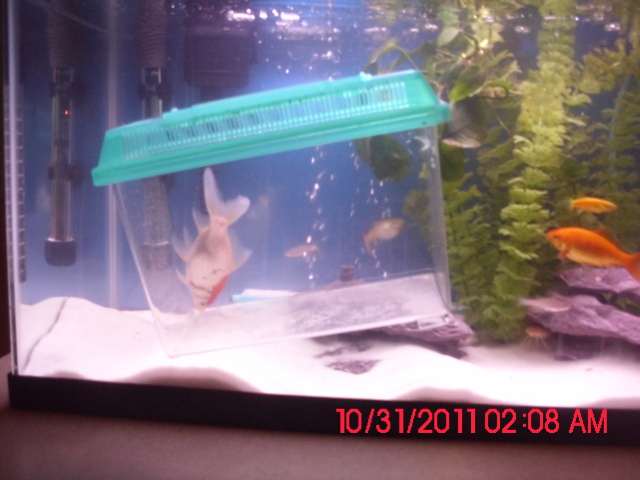 Facedown Gold fish
Question
face down gold fish
On firday i took my
Facedown Gold fish
Question
face down gold fish
On firday i took my
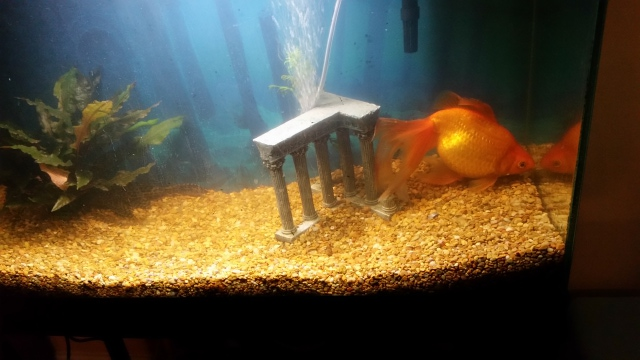 White spots and water issues
Question
Goldfish
I have 2 fish, 1 large fancy g
White spots and water issues
Question
Goldfish
I have 2 fish, 1 large fancy g
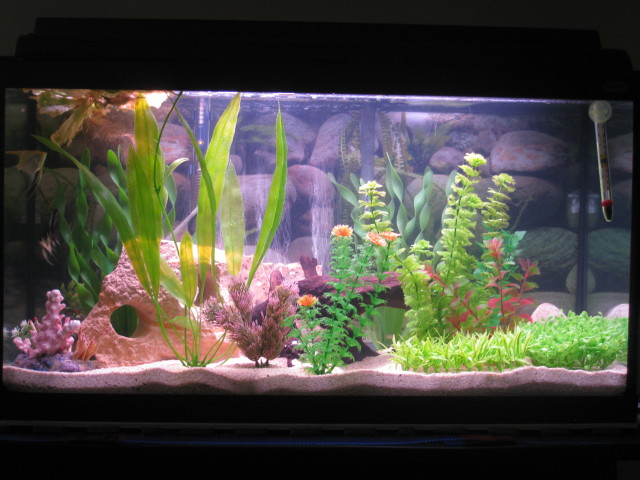 new aquarium
Question29 pic
QUESTION: does my aquarium look g
new aquarium
Question29 pic
QUESTION: does my aquarium look g
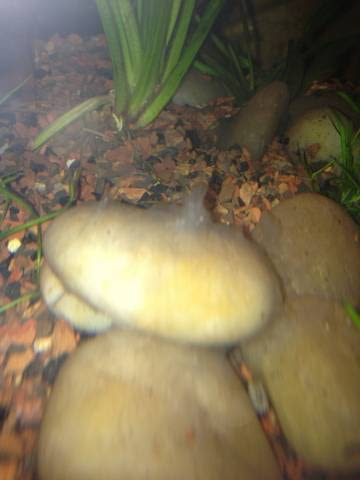 white fuzz on aquarium stones
Question
Fuzz
Hi Jaymie, I recently set up a Hag
white fuzz on aquarium stones
Question
Fuzz
Hi Jaymie, I recently set up a Hag
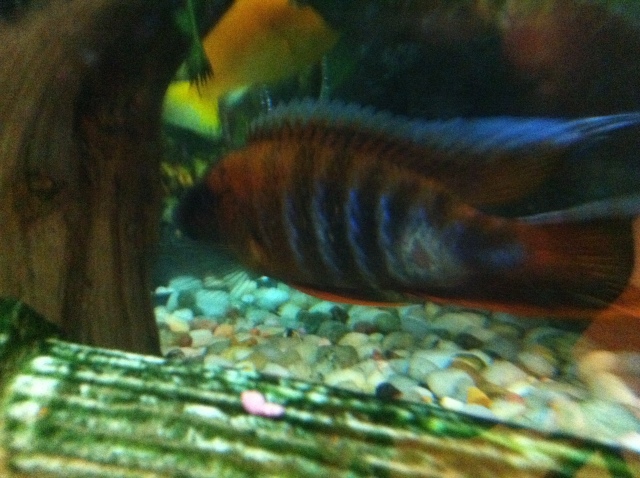 Sick cichlids! i dont want to lose them
QuestionQUESTION: Hello Renee, first off, thank you for
Sick cichlids! i dont want to lose them
QuestionQUESTION: Hello Renee, first off, thank you for